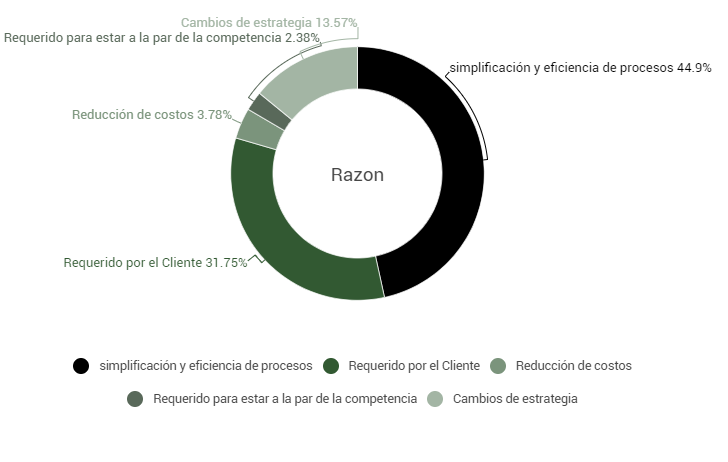
670 : 140
Use Data analytics in their digital transformation processes.
670 : 285
Data analytics is not one of their priorities
(670 – Number of companies surveyed in 10 Latin American countries in 2022 by EY Consulting)
Top reasons leading to digital transformation in Latin America
Lack of trained personnel and resistance to change are the main concerns that companies currently have to guarantee their digital transformation. How to handle this lack of talent? What does it take to have adequate change management? How should the organizational culture be transformed to achieve a more adaptive environment?
We need organizations that are willing to mold their structure and culture to a more “digital” thinking and to be more focused on the needs of the user. When this is embedded into the core of the company the common resistance to change problems are reduced, and management will embrace new business models, challenging their comfort zone and proving to be the model of success!

Industries where the digital transformation budget increased last year
- Mass Consumption and Retail – 33%
- Education – 35%
- Professional services – 36%
- Manufacturing – 36%
- Mining and Metals – 43%
- Energy and Hydrocarbons – 44%
- Agroindustria – 50%
- Logística y Transporte – 50%
- Telecommunications – 52%
- Health – 56%
- Real Estate and Construction – 66%
- Banking and insurance – 67%
- Automotive – 68%
Digital Marketing Adoption
- Increased Internet Penetration: Internet penetration in Latin America has been steadily increasing, leading to more consumers coming online.
-
Use of mobile devices: The penetration of mobile devices has increased significantly in Latin America in recent years, helping less favored sectors to take advantage of the benefits of digital commerce.
-
Improving Economy: With a growing economy, more businesses are expected to invest in digital marketing to expand their reach and attract more customers.
-
Increased digital literacy: Digital literacy in Latin America has increased, leading to increased demand for advanced digital solutions. With this new knowledge, more trust is placed in electronic/digital platforms, generating more traffic and attributing more revenue to digital.
-
Changes in shopping habits: Consumers in Latin America are changing their shopping habits and are increasingly buying online, which is driving the adoption of digital marketing.
Differences between traditional digital analytics solutions and DCx
Although these two can normally coexist, traditional digital analytics and digital customer experience analytics are two different approaches to understanding online user behavior. Some of the key differences include:
-
Focus: Traditional digital analytics focuses on technical metrics like site traffic, conversions, and time on site, while digital customer experience analytics focuses on understanding how users interact with a brand online (answer the “why?”).
-
Data: Traditional digital analytics is based on quantitative data, while digital customer experience analytics includes both quantitative and qualitative data. I.e: not only looking at where users normally click (click-through rate), but what they were focusing their activity on while engaging with content (Attractiveness Rate).
-
Scale: Traditional digital analytics is a more holistic approach that focuses on performance at the page or website level as a whole, while digital customer experience analytics is more granular and focuses on the individual user customer experience.
-
Objectives: Traditional digital analytics is primarily used to optimize efficiency and conversion, while digital customer experience analytics is used to improve customer satisfaction and loyalty.
-
Tools: Traditional digital analytics is done primarily with web analytics tools, while digital customer experience analytics is done with a combination of web analytics tools, surveys, and natural language and voice analytics.
How can we guarantee the progress of CX in Latin America?
For Latin America to progress in the digital user experience, the following steps should be considered:
-
Increase digital literacy: It’s important for companies to invest in training and education programs so that consumers are more informed and empowered to interact with brands online.
-
Improve technology infrastructure: A strong technology infrastructure is essential to deliver a smooth and seamless user experience.
-
Foster innovation:Companies must foster innovation to create more advanced solutions that improve the consumer experience.
-
Adopt Digital Marketing Solutions: Businesses need to adopt digital marketing solutions to enhance their online presence and reach more customers.
-
Continuously monitor and improve the user experience: It’s important for companies to continuously monitor and improve the user experience to maintain a high level of satisfaction and loyalty.
In summary, the combination of education, technology, innovation and digital marketing solutions can help Latin America to progress in the digital user experience and create a stronger and lasting relationship with its customers.
